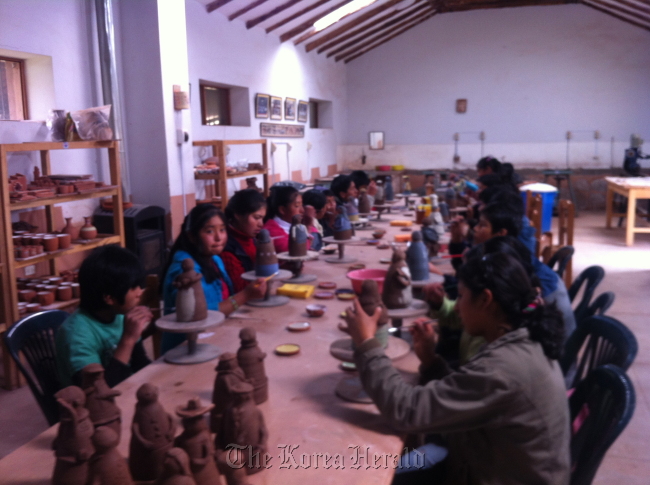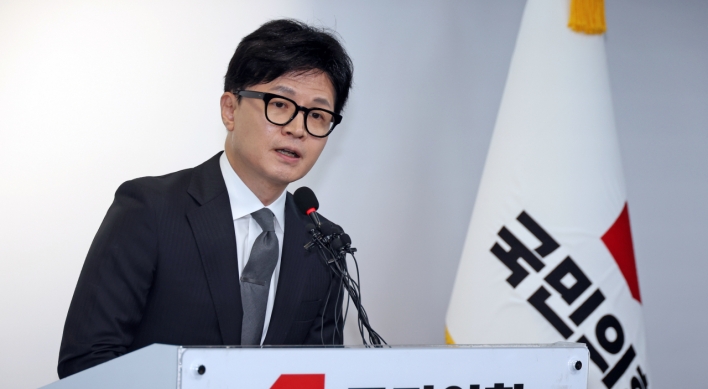KOICA shores up medical services, rural development in Peru
By Shin Hyon-heePublished : Jan. 27, 2013 - 19:32
CCORAO/PACHACUTEC, Peru ― Fresh out of high school and dismayed by his lack of resources to go to college, Orland Choque took a trip to a ceramic studio in the city of Urubamba in southeastern Peru in 2005.
Upon first contact with ceramics, he was mesmerized by its sculptural possibilities. That was his “eureka moment,” he said, which led him to sign up for a pottery school run by KOICA in his hometown Ccorao.
Choque, now 26, teaches and helps with the academy’s operations and administrative affairs after completing the beginner’s course in 2009.
“It was one of the most important events in my life,” he told The Korea Herald. “I decided to study and become a teacher thanks to a KOICA volunteer who encouraged me to have a job and get recognized in this field.”
The school was launched in 2004 as part of KOICA’s projects to help the rural village develop its economy, and underprivileged youngsters like Choque learn skills for their future.
Peru is a core destination for Korea’s official development assistance, alongside Vietnam, Indonesia, Laos, Mongolia and Tanzania. Seoul has provided almost $63 million in grant aid since 1991, focusing on medical care, rural development and energy.
Nearly 90 volunteers take part in programs across Peru, surmounting challenges ranging from altitude sickness to poor transportation to a lack of electricity, water and sewerage.
In Ccorao, KOICA provides residents with free ceramic courses in its classrooms and public schools, and they sell their output to visitors and at local craft markets. There are about 30 students per class and a few graduates have opened their own workshops, according to Park Hyung-wook, a marketing volunteer.
With agriculture remaining the mainstay of the provincial economy, the community’s roughly 2,000 people earn about $100 a month on average,
To help them create stable income sources, the state grant aid agency is aiming to open a potato-processing factory nearby next month, as well as a new town hall. It would first hire 10 people then another 20-30 over the next three years, officials said.
“Hundreds of residents have since gone through here but a very few made it to the end because it’s difficult to learn when you work hard to make a living,” said Kang Hwang-wook, vice representative of KOICA’s Peru office.
Upon first contact with ceramics, he was mesmerized by its sculptural possibilities. That was his “eureka moment,” he said, which led him to sign up for a pottery school run by KOICA in his hometown Ccorao.
Choque, now 26, teaches and helps with the academy’s operations and administrative affairs after completing the beginner’s course in 2009.
“It was one of the most important events in my life,” he told The Korea Herald. “I decided to study and become a teacher thanks to a KOICA volunteer who encouraged me to have a job and get recognized in this field.”
The school was launched in 2004 as part of KOICA’s projects to help the rural village develop its economy, and underprivileged youngsters like Choque learn skills for their future.
Peru is a core destination for Korea’s official development assistance, alongside Vietnam, Indonesia, Laos, Mongolia and Tanzania. Seoul has provided almost $63 million in grant aid since 1991, focusing on medical care, rural development and energy.
Nearly 90 volunteers take part in programs across Peru, surmounting challenges ranging from altitude sickness to poor transportation to a lack of electricity, water and sewerage.
In Ccorao, KOICA provides residents with free ceramic courses in its classrooms and public schools, and they sell their output to visitors and at local craft markets. There are about 30 students per class and a few graduates have opened their own workshops, according to Park Hyung-wook, a marketing volunteer.
With agriculture remaining the mainstay of the provincial economy, the community’s roughly 2,000 people earn about $100 a month on average,
To help them create stable income sources, the state grant aid agency is aiming to open a potato-processing factory nearby next month, as well as a new town hall. It would first hire 10 people then another 20-30 over the next three years, officials said.
“Hundreds of residents have since gone through here but a very few made it to the end because it’s difficult to learn when you work hard to make a living,” said Kang Hwang-wook, vice representative of KOICA’s Peru office.

KOICA has been at the forefront of Korea’s public diplomacy, expanding official development assistance.
Although its efforts are relatively small in funding scale and manpower, Seoul is striving to cash in on its technological expertise and knowhow for rapid economic growth,
The centerpiece of its Peru operations is a public health center in Pachacutec, some 40 kilometers northwest of Lima.
Enclosed by sand dunes, about 180,000 people that live in the area barely have access to water, landline networks and medical services.
KOICA began upgrading a rundown community health center in 2005. It spent $920,000 to reconstruct the facility, purchase equipment and hire and train doctors and nurses.
Two years later, the tiny neighborhood clinic transformed into the region’s top medical care providers operating around the clock.
The numbers of doctors shot up from eight in 2007 to 88 in 2012, while the figures for patients rose ninefold to nearly 100,000. With a main focus on mother and child care, the institute also covers dental care, internal medicine, clinical pathology, radiology and simple component analysis.
“In the past, people here gave birth at home, especially at night, because they had no car, no taxi and nowhere else to go,” said German Almonacid, head of the health center.
“Now we provide some degree of medical services to all kinds of patients, and transfer those in critical situations with an ambulance.”
The Peruvian government in 2009 picked the facility as one of the four health centers to test-run a universal health care scheme, a year before its full-fledged implementation. Then-President Alan Garcia and Health Minister Oscar Ugarte also visited there, lauding the progress.
On a usual Friday morning, it is crammed with people, trying to make an appointment or waiting for their turn in a long queue. That is always the case even during the winter, when the sand-swept area is swathed in a chilly, pea-soup smog, officials say.
But thanks to the new insurance system, 80 percent of the patients pay no fee at all and most of the remainder also receive almost free services, according to Almonacid.
Pachacutec’s success also means a boost for Korea’s standing in this faraway continent, prompting neighboring countries such as Bolivia and Jamaica to study their own versions of public medical centers.
“We did not know about Korea at all until the health center opened,” said Isabelle, a middle-aged housewife living in Pachacutec. “Now people here are always grateful for Korea and its support.”
To cater to skyrocketing demand, KOICA plans to embark on a $2.4 million expansion program this year to be finished by 2016.
The massive influx of patients has exposed the need for additional doctors, ambulances, patient rooms, equipment, storage space, labs and other things, officials said. They have handed over all operations to Peruvian staff and focused on staff education.
“The project marks our strategic approach to medical services given widespread poverty and high maternal deaths in the region,” said Park Hee-kwon, Korean ambassador to Peru.
By Shin Hyon-hee, Korea Herald Correspondent
(heeshin@heraldcorp.com)


![[Exclusive] Korean military set to ban iPhones over 'security' concerns](http://res.heraldm.com/phpwas/restmb_idxmake.php?idx=644&simg=/content/image/2024/04/23/20240423050599_0.jpg&u=20240423183955)

![[Graphic News] 77% of young Koreans still financially dependent](http://res.heraldm.com/phpwas/restmb_idxmake.php?idx=644&simg=/content/image/2024/04/22/20240422050762_0.gif&u=)



![[Pressure points] Leggings in public: Fashion statement or social faux pas?](http://res.heraldm.com/phpwas/restmb_idxmake.php?idx=644&simg=/content/image/2024/04/23/20240423050669_0.jpg&u=)









